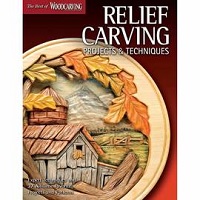Wood Carving - Preamble
CHAPTER I
PREAMBLE
Student and Apprentice, their Aims and Conditions of Work—Necessity for some Equality between Theory and Practise—The Student's Opportunity lies on the Side of Design.

CLICK HERE CLICK HERE
The study of some form of handicraft has of late years become an important element in the training of an art student. It is with the object of assisting such with practical directions, as well as suggesting to more practised carvers considerations of design and treatment, that the present volume has been written. The art of wood-carving, however, lends itself to literary demonstration only in a very limited way, more especially in the condensed form of a text-book, which must be looked upon merely as a temporary guide, of use only until such time as practise and study shall have strengthened the judgment of the student, and enabled [26] him to assimilate the many and involved principles which underlie the development of his craft.
If the beginner has mastered to some extent the initial difficulties of the draftsman, and has a fair general knowledge of the laws of design, but no acquaintance with their application to the art of wood-carving, then the two factors which will most immediately affect his progress (apart from natural aptitude) are his opportunities for practise, and his knowledge of past and present conditions of work. No one can become a good carver without considerable practise—constant, if the best results are to be looked for. Just as truly, without some knowledge of past and existing conditions of practise, none may hope to escape the danger of becoming, on the one hand, dull imitators of the superficial qualities of old work; or on the other, followers of the first will-o'-the-wisp novelty which presents itself to their fancy.
If use of the tools and knowledge of materials were the only subjects of which a carver need become master, there would be no way equal to the old-fashioned one of apprenticeship to some good craftsman. [27] Daily practise with the tools insures a manual dexterity with which no amateur need hope to compete. Many traditional expedients are handed down in this way that can be acquired in no other. There is, however, another side of the question to be considered, of quite as much importance as the practical one of handicraft skill. The art of wood-carving has also to fulfil its intellectual function, as an interpreter of the dreams and fancies of imagination. In this respect there is little encouragement to be looked for in the dull routine of a modern workshop.
There are, therefore, two widely separated standpoints from which the art may be viewed. It may be looked at from the position of a regular craftsman, who regards it primarily as his means of livelihood; or it may be dealt with as a subject of intellectual interest, based upon its relation to the laws of art in general. As, in the first instance, the use of the tools can not be learned without some accompanying knowledge of the laws of art, however slight that acquaintance may be, the method of apprenticeship has the advantage of being the more practical of the two; but it must be accepted with all the [28] conditions imposed upon it by the pressure of commercial interest and its usages: conditions, which, it may easily be imagined, are far more favorable to the performance of dull task-work, than to the adventurous spirit of curiosity which should prompt the enterprise of an energetic student.
On the other hand, although an independent study of the art offers a wider range of interest, the student is, for that very reason, exposed to the risk of involving himself in a labyrinth of confusing and ineffectual theories. The fact is, that neither method can at the present time be exclusively depended upon as a means of development; neither can be pronounced complete in itself nor independent of the other. The only sure safeguard against the vagueness of theory is constant practise with the tools; while, to the craftsman in the full enjoyment of every means for exercising and increasing his technical skill, a general study and intelligent conception of the wide possibilities of his art is just as essential, if it were only as an antidote to the influence of an otherwise mechanical employment. The more closely these contradictory views are made [29] to approximate, the more certain will become the carver's aims, and the clearer will be his understanding of the difficulties which surround his path, enabling him to choose that which is practicable and intrinsically valuable, both as regards the theory and practise of his art.
If the student, through lack of opportunities for practise, is debarred from all chance of acquiring that expertness which accompanies great technical skill, he may at least find encouragement in the fact that he can never exhaust the interest afforded by his art in its infinite suggestion to the imagination and fancy; and also that by the exercise of diligence, and a determination to succeed, he may reasonably hope to gain such a degree of proficiency with the tools as will enable him to execute with his hands every idea which has a definite existence in his mind. Generally speaking, it will be found that his manual powers are always a little in advance of his perceptions.
Thus the student may gradually work out for himself a natural and reliable manner of expressing his thoughts, and in a way, too, that is likely to compensate for his technical shortcomings, by exciting [30] a more lively interest in the resources of the art itself. The measure of his success will be determined partly by his innate capacity for the work, and partly by the amount of time which he is enabled to give to its practise. The resources of his art offer an infinite scope for the exercise of his powers of design, and as this is the side which lies nearest to his opportunities it should be the one which receives his most earnest attention, not merely as experiments on paper, but as exercises carried out to the best of his ability with the tools. Such technical difficulties as he may encounter in the process will gradually disappear with practise. There is also encouragement in the thought that wood-carving is an art which makes no immediate calls upon that mysterious combination of extraordinary gifts labeled "genius," but is rather one which demands tribute from the bright and happy inspirations of a normally healthy mind. There is, in this direction, quite a life's work for any enthusiast who aims at finding the bearings of his own small but precious gift, and in making it intelligible to others; while, at the same time, keeping himself free from the many confusions and affectations which surround him in the endeavor. [31]

|
INFORMATION ABOUT HOW TO MAKE MONEY FROM WOOD CARVING |

